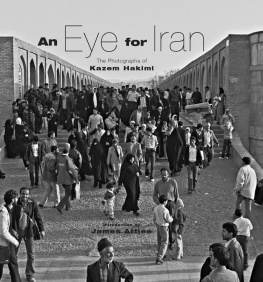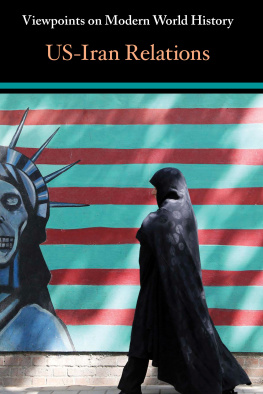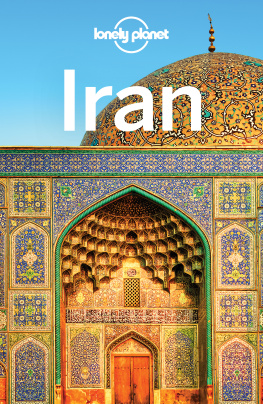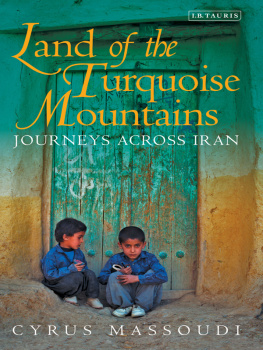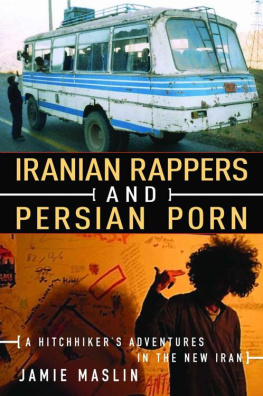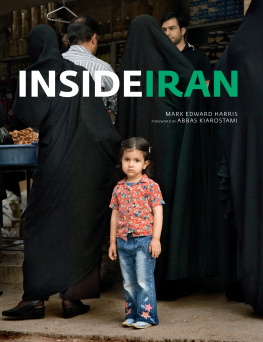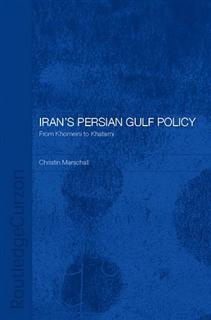Acknowledgements
I would like to thank Dan Nunn of Garnet Publishing for commissioning this book and being so accommodating; Paul Sims of ColourBox TechUnique for digitizing the images from negatives, without whose help and expertise this project would not have been possible; Keith Barnes and Matt Pitt of the Photographers Workshop for kindly developing all my negatives; James Attlee for gracing this book with his beautiful introduction; Nick Quartley at the North Wall Arts Centre, Oxford, for giving me the opportunity to stage the exhibition from which these photographs are taken; Lindsay Jones of Oxford Framing Service for his great frames; and nally, my family and countless friends, to whom I am indebted for all their valuable help and support.
Kazem Hakimi (kazemhakimi@hotmail.com)
A N E YE FOR I RAN
The Photographs of Kazem Hakimi
Published by
Garnet Publishing Limited
8 Southern Court
South Street
Reading
Berkshire
RG1 4QS
UK
www.garnetpublishing.co.uk
Copyright Kazem Hakimi, 2009
Introduction text James Attlee, 2009
All rights reserved.
No part of this book may be reproduced in any form or by any electronic or mechanical means, including information storage and retrieval systems, without permission in writing from the publisher, except by a reviewer who may quote brief passages in a review.
First Edition
ISBN-13: 9781859644317
British Library Cataloguing-in-Publication Data
A catalogue record for this book is available from the British Library
Typeset by Samantha Barden
Jacket design by David Rose
Printed in Hong Kong through Printworks Int. Ltd.
INTRODUCTION
For my beloved spiritual master Grand Sheikh Mohammad Nazim Adil Al-Qubrusi, who has always blessed me with his endless spirituality; and to my dear wife Carolyn for being the most wonderful wife and the backbone of my family.
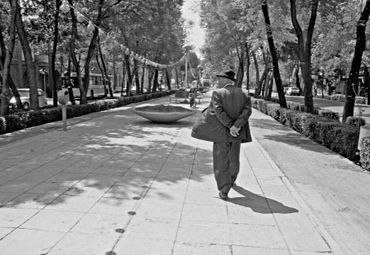
A man at the latter end of middle age (although his age is unimportant) strolls down a leafy boulevard, unaccompanied except for his own shadow. Dressed in a baggy suit that could date from the 1940s rather than the 21st century, with a hat crammed down on his head, he is walking ahead of the photographer, his hands clasped behind his back. There is something at once casual and purposeful about his stride as he progresses into the middle distance, a direction our eyes are led in by a seemingly endless string of light bulbs that hangs between the lamp posts above his head. At the moment the photographer has captured, a puff of wind gently inates his jacket and he turns his face to his left so that we see him in prole, his expression neither happy nor sad, simply observant.
This is not a photograph for those who are looking for action, narrative or high drama. I rst saw it on the wall in an exhibition. Two weeks later, when I happened to run into the photographer, it was still fresh in my mind. I described it to him: the one of the man in the suit walking who turns his head, just as the wind catches out his jacket? Kazem Hakimi grew animated, as photographers tend to do when they discuss their work. Yes, yes, he said, I had to walk behind him for fteen minutes before that happened. Did you notice how his jacket and the plant pot are the same shape?
I wasnt sure I had noticed, so I returned to the image once more. Sure enough, the stroller, the flneur if you will, is approaching a concrete planter in the middle of the pavement that looks like a ying saucer, or the mouth of a lily. The mans jacket, flaring out at the waist, is an inversion of the shape, like a bell. The photographer, stalking the solitary figure ahead of him, has waited for this instant, when the action of the wind and the congruence of physical appearances all come together, and he can press the shutter. This moment, when nothing much happens, is nevertheless a well in which we can immerse ourselves again and again, an intensely experienced fragment of the present.
It is a very European photograph; or at least, it is very much in a European and American tradition of street photography, both in its subject and in the process of its creation the photographer stalking his, or her, prey, waiting for that moment to arrive in which chance and expectations collide. Even the technology used black-and-white lm loaded into a Canon SLR is little changed from the rst half of the twentieth century. The shadows cast by the trees on the pavement are a motif familiar in dozens of works from the period. The mans clothes are timeless; the streets either side of the pavement are eerily empty of trafc.The photographer has somehow achieved invisibility, able to freeze a moment on lm without interrupting the ow of the late afternoon. Yet we are not in Paris or New York, but Isfahan; we know the photograph was taken in 2004. Has the camera become a time machine, transporting us back to an earlier age? Or, indeed, a method of translating for us a foreign scene into a language we understand, letting us breathe the atmosphere of a sidewalk few of us will ever visit, in a country more often represented in the hyperbole of politicians speeches? We must ask ourselves, as we have to when looking at any photographic image, who is the photographer and where do they stand in relation to what they are photographing?
Let us consider another image that deals with this question explicitly, the only photograph in the collection to depict visitors from outside the country. The scene takes place in Naqsh-e Jahan Square in Isfahan, the second largest public square in the world.Three German tourists are sitting on a bench, engaged in friendly interaction with a family group; the woman among them has covered her head out of respect for local custom, as instructed in her guidebook. An Iranian boy, perhaps 10 years old, is doing a dance for the elderly German man, who is taking his photograph. The boys siblings, or friends, look on, amused. Again, the scene is beautifully composed.The dancing boys outstretched arms echo the crucix formed by the paths he is standing on; the horizon behind him is formed by the long, low outline of the Sheikh Lotfollah Mosque, unique among mosques for not possessing a minaret. A younger boy, hands in pockets, looks straight at the camera, his face a picture of wry amusement. What we are seeing is a photograph depicting photography itself, a particular type of photography: the photograph being taken by the Germans is a touristic one, perhaps the only kind it is possible at this moment and in this place for them to take, for as foreigners they attract to themselves the attention of small boys and smiling young women. Not for them the possibility of strolling unnoticed down sunlit boulevards scored by shadows, simply observing the passing scene. The gure in the rst photograph, you may have realized, is a cipher for the photographer himself, a wanderer of the streets and squares, a collector of eeting impressions. By contrast, the man bearing the camera in the second photograph represents the fate of the Western visitor to another culture, condemned to be the centre of attention, whose very presence changes what is happening before his eyes to an extent that makes un-staged photography all but impossible.


